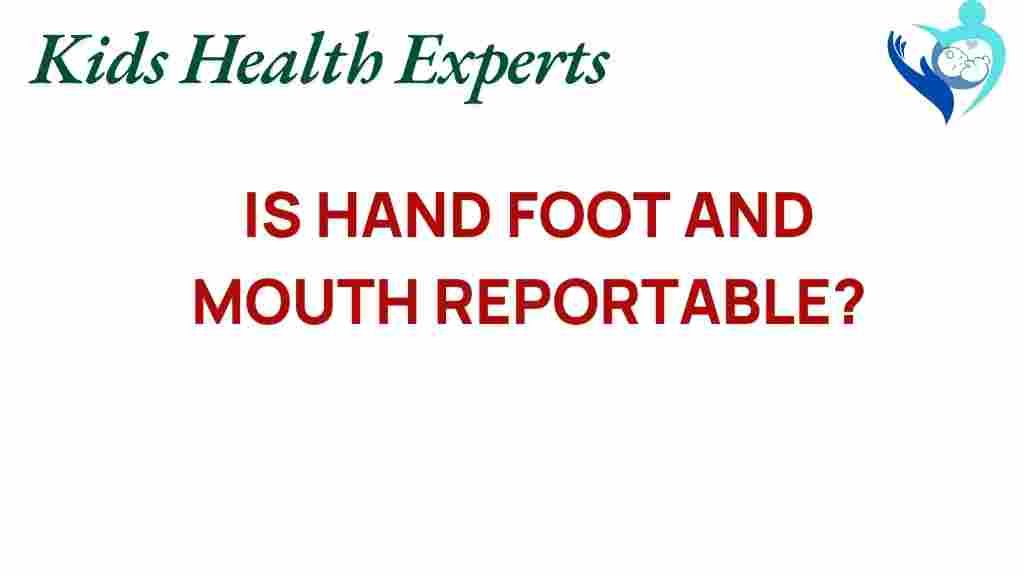Is Hand, Foot, and Mouth Disease Reportable? What You Need to Know
Hand, Foot, and Mouth Disease (HFMD) is a common viral illness primarily affecting children under five years of age, though it can occasionally affect older children and adults. It is characterized by fever, sores in the mouth, and a rash on the hands and feet. As healthcare professionals, understanding the reportability of Hand, Foot, and Mouth Disease is crucial for managing outbreaks and protecting public health. In this article, we will explore whether HFMD is a reportable disease, its symptoms, transmission methods, prevention strategies, and the role of healthcare professionals in managing cases.
Understanding Reportable Diseases
Reportable diseases are those that healthcare providers are required to report to public health authorities. This reporting is essential for monitoring the spread of diseases, identifying outbreaks, and implementing control measures. The list of reportable diseases varies by country and state, depending on local public health laws.
Is Hand, Foot, and Mouth Disease Reportable?
In many jurisdictions, Hand, Foot, and Mouth Disease is not classified as a reportable disease. However, healthcare professionals should be aware that significant outbreaks may need to be reported to local health departments. The decision to report is often based on the severity of the outbreak and the number of cases observed in a short period. If you suspect an outbreak is occurring, it is prudent to consult your local public health authority.
Symptoms of Hand, Foot, and Mouth Disease
The symptoms of Hand, Foot, and Mouth Disease can vary but typically include:
- Fever: Often the first sign of HFMD.
- Sore Throat: Painful swallowing may occur.
- Mouth Sores: Painful sores or ulcers can develop in the mouth.
- Rash: Red spots or blisters can appear on the hands, feet, and sometimes the buttocks.
- General Discomfort: Children may feel irritable and tired.
Symptoms usually resolve within a week, but it’s important for parents and caregivers to monitor the child and seek medical advice if symptoms worsen.
Transmission of Hand, Foot, and Mouth Disease
HFMD is caused by several different viruses, most commonly the Coxsackievirus. The disease is highly contagious and can spread through:
- Direct Contact: With the saliva, blister fluid, or feces of an infected person.
- Airborne Transmission: Through respiratory droplets when an infected person coughs or sneezes.
- Contaminated Surfaces: Touching surfaces or objects that have the virus on them.
Prevention Strategies
Preventing the spread of Hand, Foot, and Mouth Disease is crucial, especially in childcare settings and schools. Here are some effective prevention strategies:
- Good Hygiene Practices: Encourage frequent handwashing with soap and water, especially after changing diapers or using the restroom.
- Disinfect Surfaces: Regularly clean and disinfect frequently-touched surfaces and toys.
- Avoid Close Contact: Keep infected children away from others, particularly in group settings.
- Stay Home When Sick: Infected individuals should stay home until they are fully recovered.
The Role of Healthcare Professionals
Healthcare professionals play a vital role in managing Hand, Foot, and Mouth Disease. Here are some key responsibilities:
- Diagnosis: Recognizing the symptoms and confirming the diagnosis through clinical evaluation.
- Education: Informing parents and caregivers about the nature of the disease, its symptoms, and preventive measures.
- Reporting: Assessing the need to report cases based on local guidelines and potential outbreaks.
- Support: Providing supportive care recommendations, including pain management and hydration tips.
Step-by-Step Process for Managing HFMD Cases
Here is a step-by-step process for healthcare professionals when managing cases of Hand, Foot, and Mouth Disease:
- Initial Assessment: Evaluate the patient’s symptoms and medical history.
- Clinical Diagnosis: Confirm HFMD based on symptoms and physical examination.
- Patient Education: Discuss the nature of HFMD, its contagiousness, and care at home.
- Monitoring: Schedule follow-up appointments if necessary, especially for high-risk patients.
- Reporting: Determine if the case should be reported based on local health department guidelines.
Troubleshooting Tips for Parents and Caregivers
For parents and caregivers, knowing how to manage a child with Hand, Foot, and Mouth Disease can be overwhelming. Here are some troubleshooting tips:
- Manage Fever: Use age-appropriate fever reducers, like acetaminophen or ibuprofen, as recommended by your healthcare provider.
- Encourage Fluid Intake: Make sure your child stays hydrated; offer fluids like water, electrolyte solutions, or soft drinks.
- Soft Foods: Serve soft, bland foods that are easy to swallow and won’t irritate mouth sores.
- Monitor Symptoms: Keep track of any changes in symptoms and seek medical advice if they worsen.
Conclusion
In summary, while Hand, Foot, and Mouth Disease is not universally classified as a reportable disease, healthcare professionals must remain vigilant in recognizing outbreaks and understanding their role in public health. By being aware of the symptoms, transmission methods, and prevention strategies, we can work together to minimize the impact of HFMD. For more information on public health guidelines regarding reportable diseases, consult your local health department or visit CDC’s website. Remember, effective communication and education are key in managing this common viral illness.
For further reading about reportable diseases and their implications, check out this informative article.
This article is in the category Conditions and created by KidsHealthExperts Team
